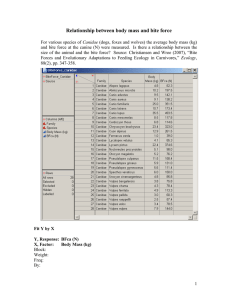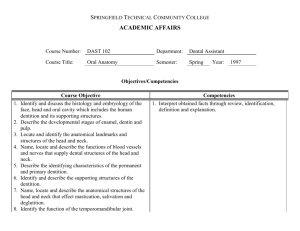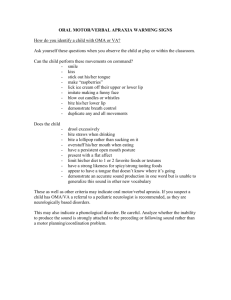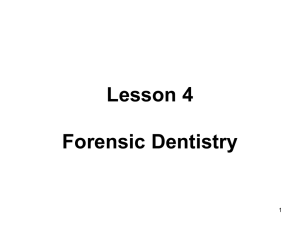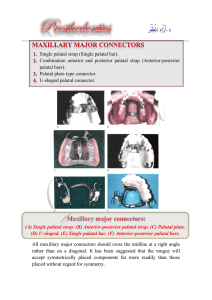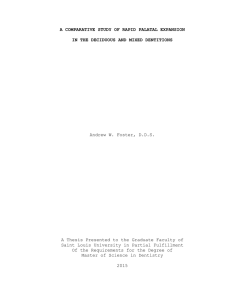SVPCA Posters
advertisement
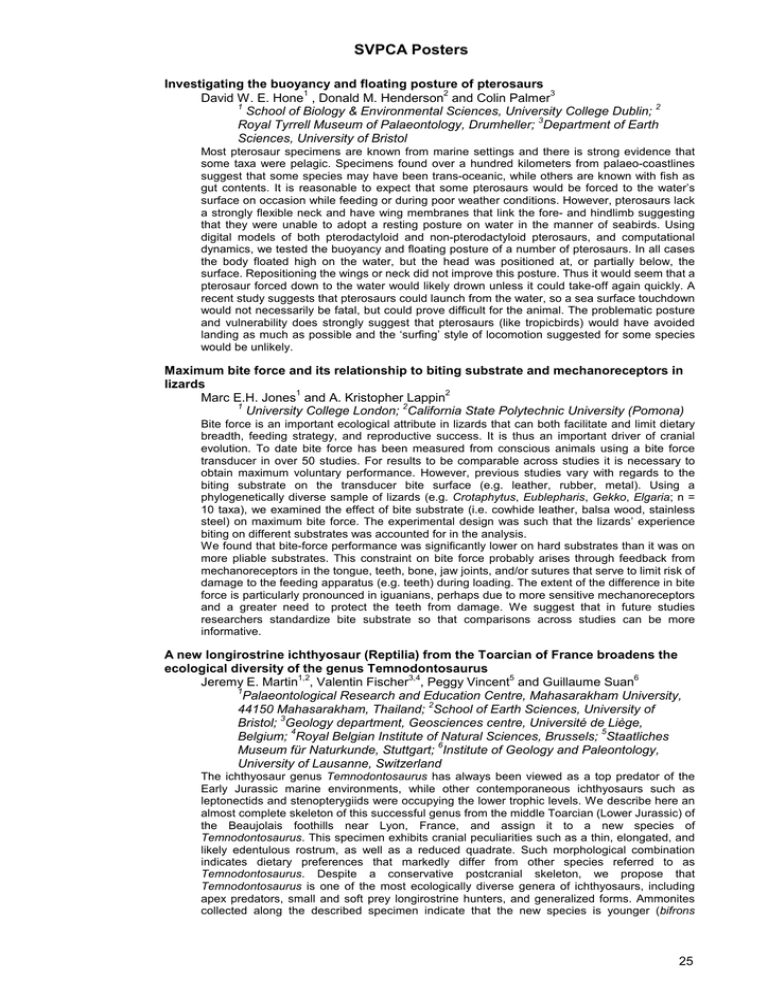
SVPCA Posters Investigating the buoyancy and floating posture of pterosaurs 1 2 3 David W. E. Hone , Donald M. Henderson and Colin Palmer 1 2 School of Biology & Environmental Sciences, University College Dublin; 3 Royal Tyrrell Museum of Palaeontology, Drumheller; Department of Earth Sciences, University of Bristol Most pterosaur specimens are known from marine settings and there is strong evidence that some taxa were pelagic. Specimens found over a hundred kilometers from palaeo-coastlines suggest that some species may have been trans-oceanic, while others are known with fish as gut contents. It is reasonable to expect that some pterosaurs would be forced to the water’s surface on occasion while feeding or during poor weather conditions. However, pterosaurs lack a strongly flexible neck and have wing membranes that link the fore- and hindlimb suggesting that they were unable to adopt a resting posture on water in the manner of seabirds. Using digital models of both pterodactyloid and non-pterodactyloid pterosaurs, and computational dynamics, we tested the buoyancy and floating posture of a number of pterosaurs. In all cases the body floated high on the water, but the head was positioned at, or partially below, the surface. Repositioning the wings or neck did not improve this posture. Thus it would seem that a pterosaur forced down to the water would likely drown unless it could take-off again quickly. A recent study suggests that pterosaurs could launch from the water, so a sea surface touchdown would not necessarily be fatal, but could prove difficult for the animal. The problematic posture and vulnerability does strongly suggest that pterosaurs (like tropicbirds) would have avoided landing as much as possible and the ‘surfing’ style of locomotion suggested for some species would be unlikely. Maximum bite force and its relationship to biting substrate and mechanoreceptors in lizards 1 2 Marc E.H. Jones and A. Kristopher Lappin 1 2 University College London; California State Polytechnic University (Pomona) Bite force is an important ecological attribute in lizards that can both facilitate and limit dietary breadth, feeding strategy, and reproductive success. It is thus an important driver of cranial evolution. To date bite force has been measured from conscious animals using a bite force transducer in over 50 studies. For results to be comparable across studies it is necessary to obtain maximum voluntary performance. However, previous studies vary with regards to the biting substrate on the transducer bite surface (e.g. leather, rubber, metal). Using a phylogenetically diverse sample of lizards (e.g. Crotaphytus, Eublepharis, Gekko, Elgaria; n = 10 taxa), we examined the effect of bite substrate (i.e. cowhide leather, balsa wood, stainless steel) on maximum bite force. The experimental design was such that the lizards’ experience biting on different substrates was accounted for in the analysis. We found that bite-force performance was significantly lower on hard substrates than it was on more pliable substrates. This constraint on bite force probably arises through feedback from mechanoreceptors in the tongue, teeth, bone, jaw joints, and/or sutures that serve to limit risk of damage to the feeding apparatus (e.g. teeth) during loading. The extent of the difference in bite force is particularly pronounced in iguanians, perhaps due to more sensitive mechanoreceptors and a greater need to protect the teeth from damage. We suggest that in future studies researchers standardize bite substrate so that comparisons across studies can be more informative. A new longirostrine ichthyosaur (Reptilia) from the Toarcian of France broadens the ecological diversity of the genus Temnodontosaurus 1,2 3,4 5 6 Jeremy E. Martin , Valentin Fischer , Peggy Vincent and Guillaume Suan 1 Palaeontological Research and Education Centre, Mahasarakham University, 2 44150 Mahasarakham, Thailand; School of Earth Sciences, University of 3 Bristol; Geology department, Geosciences centre, Université de Liège, 4 5 Belgium; Royal Belgian Institute of Natural Sciences, Brussels; Staatliches 6 Museum für Naturkunde, Stuttgart; Institute of Geology and Paleontology, University of Lausanne, Switzerland The ichthyosaur genus Temnodontosaurus has always been viewed as a top predator of the Early Jurassic marine environments, while other contemporaneous ichthyosaurs such as leptonectids and stenopterygiids were occupying the lower trophic levels. We describe here an almost complete skeleton of this successful genus from the middle Toarcian (Lower Jurassic) of the Beaujolais foothills near Lyon, France, and assign it to a new species of Temnodontosaurus. This specimen exhibits cranial peculiarities such as a thin, elongated, and likely edentulous rostrum, as well as a reduced quadrate. Such morphological combination indicates dietary preferences that markedly differ from other species referred to as Temnodontosaurus. Despite a conservative postcranial skeleton, we propose that Temnodontosaurus is one of the most ecologically diverse genera of ichthyosaurs, including apex predators, small and soft prey longirostrine hunters, and generalized forms. Ammonites collected along the described specimen indicate that the new species is younger (bifrons 25 ammonite zone) than most known Toarcian ichthyosaurs and therefore slightly postdates the severe environmental changes and marine invertebrate extinctions that occur during the Toarcian Oceanic Anoxic Event. The present study hence raises the question whether the speciation of Temnodontosaurus towards a new ecological niche, may have been a consequence of the post-crisis marine ecosystem reorganization. A new species of Ichthyosaurus from the Pliensbachian of the Charmouth area. 1 2 Dean R. Lomax and Judy A. Massare (supported by Jones-Fenleigh Memorial Fund) 1 2 Doncaster Museum & Art Gallery; Earth Sciences Department, SUNY College at Brockport A well preserved ichthyosaur (DONMG:1983.98) from the palaeontology collection of the Doncaster Museum and Art Gallery was recently “rediscovered”. The incomplete, laterally flattened skeleton includes a skull, articulated dorsal and cervical vertebrae with ribs, a nearly complete pectoral girdle, and an articulated forelimb. A specimen of the Pliensbachian belemnite Bairstowius junceus, preserved on the same slab as the ichthyosaur, indicates that the specimen originated from the Stonebarrow Marl Member of the Charmouth Mudstone Formation. Morphology of the shoulder girdle and forelimb suggest that this specimen is an Ichthyosaurus, thus extending the range of the genus to the Pliensbachian. Preliminary examination of skull proportions and tooth morphology suggest that the specimen represents a new species, but work is ongoing. Of additional interest are preserved gut contents of cephalopod hooklets found among the ribs of the specimen. Function of palatal dentition 1,2 1 Ryoko Matsumoto and Susan Evans 1 2 University College London; National Museum of Nature and Science Any consideration of feeding in extinct vertebrates will include detailed discussion of the marginal dentition, but far less attention has been paid to the palatal dentition. Although there is a general acceptance that the palatal dentition is plesiomorphic for amniotes, its evolutionary history and function are not well understood. During feeding, the tongue and palate cooperate in gripping, intra-oral transport, and swallowing, thus modification of the palatal dentition should reflect changes in feeding behaviour and/or changes in the anatomy of the oral soft tissues. Potentially, therefore, a better understanding of the role of the palatal dentition may provide an additional source of information on the biology of extinct tetrapods. This study focuses on variation and changes in the palatal dentition through the evolutionary history of amniotes. On the phylogenetic tree, the palatal dentition is discussed on the basis of literature review, as are ideas on the function of palatal teeth. There are differences between groups with respect to the arrangement of the palatal dentition and pattern of loss. Palatal teeth may be considered as having an important role in the action of holding and manipulating food within the mouth (although they may occasionally contribute to food reduction). The challenge is then to provide an explanation for the subsequent loss/reduction of this important gripping surface in derived members of most major tetrapod lineages. The hypothesis is that this loss/reduction was linked, in each case, with functional, anatomical, or lifestyle changes that rendered a palatal gripping surface less important. Virtual reconstruction of the brain and sinuses of the basal marine crocodylomorph Pelagosaurus typus 1,2 1 3 SE Pierce , ME Williams and RBJ Benson 1 2 University Museum of Zoology, Cambridge; Department of Veterinary Basic Sciences and Structure and Motion Laboratory, The Royal Veterinary College, 3 Hatfield; Department of Earth Sciences, University of Cambridge Fossil crocodile brains and associated sinuses are poorly studied, but potentially offer valuable functional paleoneurological and evolutionary insights. Recent acquisition of micro-CT scan data of the skull of Pelagosaurus typus, a Jurassic thalattosuchian, provides an excellent opportunity to reconstruct the endocast of a basal marine crocodylomorph. Results indicate a suite of unique and functionally intriguing anatomical features including: 1) dorsally positioned paranasal sinuses – allowing the snout to develop a circular cross section conferring a constant mechanical bending strength in all directions; 2) enlarged cerebrum – possibly correlated with more complex cognition and behaviours; 3) bulbous pituitary – potentially increasing water absorption and reducing dehydration in a marine environment; 4) sizable occulomotor nerves – consistent with large orbits and suggesting the ability to process large quantities of visual information; 5) dorsoposteriorly expanded longitudinal venous sinuses – indicative of increased blood flow through the brain; 6) semicircular canals as high as long – closer in shape to more terrestrially adapted archosaurs; and 7) a wide and ventromedially extended cochlear duct – potentially increasing the range of detectable sound frequencies. Taken together, the morphology of the brain and associated sinuses in Pelagosaurus implies that this basal crocodylomorph was a highly visual and active marine predator that may have had increased social complexity. However, the data also suggests that Pelagosaurus was most likely only 26
